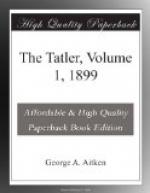From 1705 onwards there is evidence of frequent and familiar intercourse between Swift and Addison and Steele. After Sir William Temple’s death, Swift had become chaplain to the Earl of Berkeley, who gave him the living of Laracor; and during a visit to England in 1704 he had gained a position in the front rank of authors by the “Tale of a Tub” and the “Battle of the Books.” At the close of 1707 he was again in England, charged with a mission to obtain for the Irish clergy the remission of First Fruits and Tenths already conceded to the English, and throughout 1708 what he calls “the triumvirate of Addison, Steele and me” were in constant communication. In that year Swift published a pamphlet called “A Project for the Advancement of Religion and the Reformation of Manners,” which anticipated many of the arguments used in the Tatler and Spectator; and he also commenced his attack on John Partridge, quack doctor and maker of astrological almanacs. On the appearance of Partridge’s “Merlinus Liberatus” for 1708, Swift—borrowing a name from the signboard of a shoemaker—published “Predictions for the year 1708, wherein the month and day of the month are set down, the persons named, and the great actions and events of next year particularly related, as they will come to pass. Written to prevent the people of England from being further imposed on by vulgar almanack-makers. By Isaac Bickerstaff, Esq.” Isaac Bickerstaff professed to be a true astrologer, disgusted at the lies told by impostors, and he said that he was willing to be hooted at as a cheat if his prophecies were not exactly fulfilled. His first prediction was that Partridge would die on the 29th of March; and on the 30th a second pamphlet




